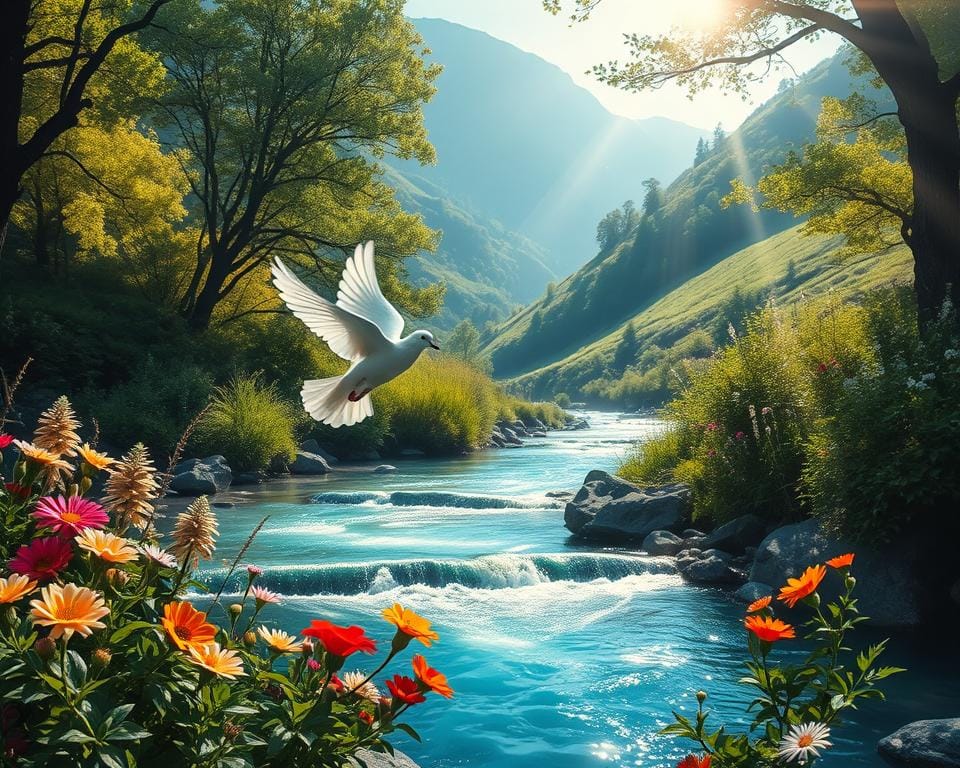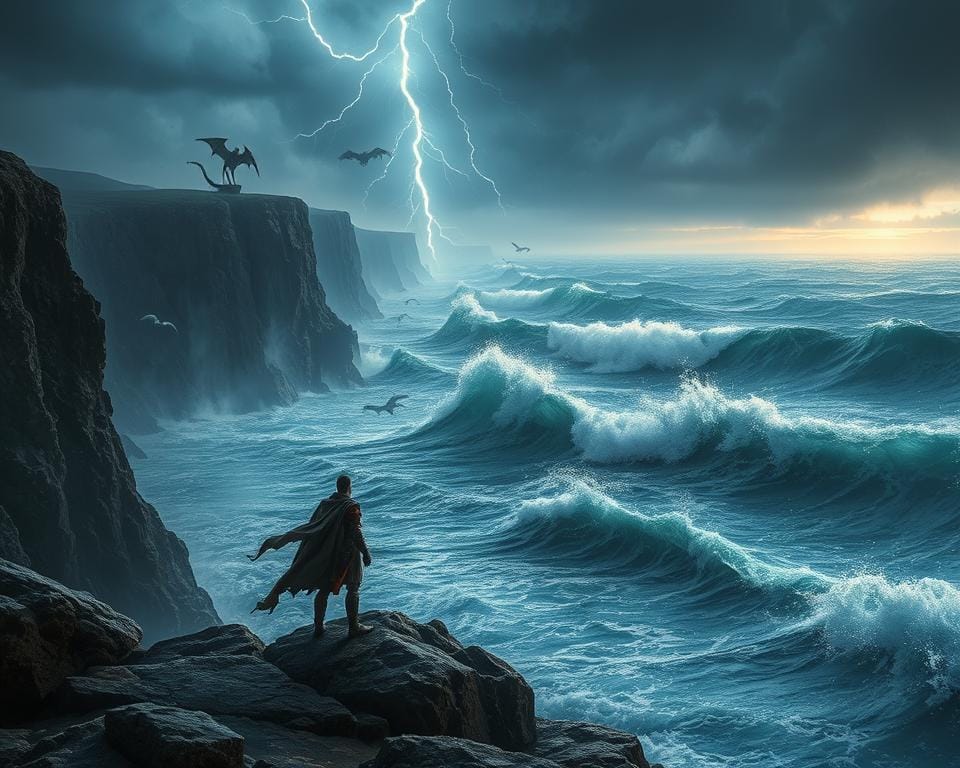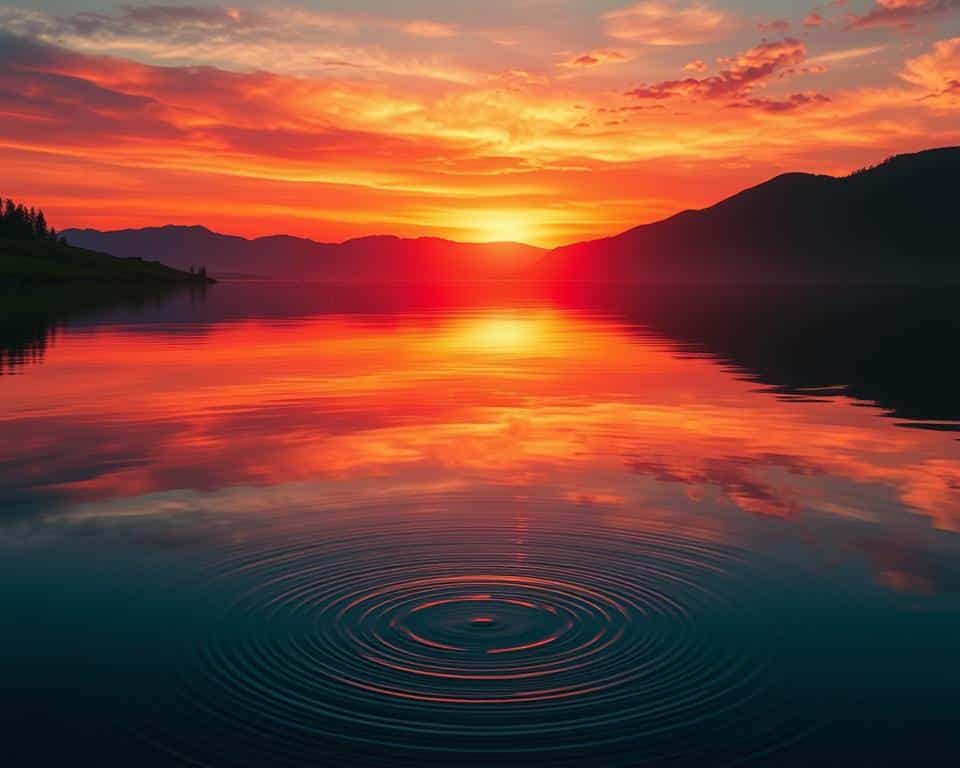Water is more than just a background in classic stories. It often carries a deeper meaning. It has been a powerful symbol, expressing ideas of spirituality, emotions, and change. In myths, water has even been seen as the start of the universe. It plays a big role in tales of gods and heroes in Greek epics too.
“The Rime of the Ancient Mariner” by Samuel Taylor Coleridge talks about a unique trouble. It shows the struggle of being at sea but not having fresh water to drink. Then, John Masefield’s “Sea-Fever” sees the sea as a call to adventure and mystery. T.S. Eliot’s “The Dry Salvages” uses water imagery to touch on deep, philosophical ideas.
Poems also reflect water’s special place in storytelling. Philip Larkin’s “Water” sees it as a source of purity and unity. He imagines a religion where water is central. In “The Fountain,” Charles Baudelaire views water as a sign of love and longing. Marin Sorescu’s “Fountains in the Sea” sees water as a symbol of endless desire and life’s cycles.
Water’s rich imagery connects life and art together. It speaks to themes of birth, ruin, and rebirth. Throughout history, poets from ancient times to now have been fascinated by water. It remains a key topic in many poems, showing its lasting impact.
Water symbolizes different things based on where you are and what you believe. Works like “A Bigger Splash” by David Hockney and “Birth of Venus” by Sandro Botticelli show this variety. Water also plays a vital role in making art, especially in watercolor paintings.
To learn more about the intricate depictions of water in mythology, you can visit this link. Similarly, for an insightful comparison of water types, check out this article.
Mythological Symbolism of Water
Water has always been a powerful symbol in myths around the world. It is found in creation stories, tales of the beginning of the universe, and stories about gods of water. This shows how important water is in our legends and storytelling. Water has two main qualities—it can give life and also destroy, cleanse and create chaos.
Creation and Primordial Chaos
In many myths, the world starts from water. In Egyptian myths, everything begins with the waters of Nun. Mesopotamian stories tell us about the birth of the world from fresh and saltwater. These stories show water as a source of life and possibility.
Water symbols vary across regions but always hold deep meaning. The Ganges River and the Well of Urd are just two examples. If you want to know more about these symbols, check out this site here.
Purification and Renewal
Most myths talk about water’s power to clean the body and soul. Flood stories, like Noah’s Ark, use water to wash away sin. Greek myths also talk about new beginnings through water’s cleansing power. These stories highlight how water can turn disorder into order and dirtiness into cleanliness.
Sacred baths in the River Styx and the Ganges point to renewal and purification. These ancient beliefs connect to today’s concerns about water’s purity and its future. Learn more about water in these rituals here.
Dual Nature: Nourishment and Destruction
Water’s dual nature is key in many myths. It can both support life and cause destruction. In Roman myths, Neptune brings the sea’s riches but also dangerous storms. In Hindu stories, the goddess Ganga brings life but also has the power to flood.
This balance between helping and harming shows water’s complex role in myths. Mesopotamian tales of Tiamat highlight this conflict between order and chaos. These stories make me think about our relationship with water as a crucial resource and a force to respect.
| Region | Water Symbol | Significance |
|---|---|---|
| Greek Mythology | River Styx | Purification and transition |
| Hindu Mythology | Ganges River | Purification and life-giving |
| Norse Mythology | Well of Urd | Wisdom and creation |
| Japanese Mythology | temizuya | Purification and renewal |
| Egyptian Mythology | Nile River | Rebirth and fertility |
| Native American Mythologies | Sacred Rivers | Life-giving and spiritual significance |
| African Mythologies | Oshun | Love and fertility |
Water in Christian Narratives
Water holds deep meaning in Christian stories. It symbolizes spiritual rebirth, divine help, and being morally clean. These ideas are found throughout the Bible. They make the faith experience deeper for believers.
Water as Baptism
Baptism uses water for spiritual cleaning and starting anew. It marks joining the Christian community. The baptism of Jesus by John the Baptist in the Jordan River is a key moment. It shows water’s crucial role in spiritual rebirth in Christian faith.

Miracles Involving Water
Miracles with holy water stand out in Christian stories. Examples include Jesus turning water into wine and walking on water. These events show water’s power to change and represent God’s power. Water in these stories strengthens faith and signals God’s miracles.
The Fountain of Life
The “Fountain of Life” highlights water’s holiness in Christianity. The river from God’s throne in the Book of Revelation means eternal life and support from God. It connects water and life, showing water as a source of God’s grace. This theme shows water’s link to everlasting life and spiritual plenty.
Water as a Test for Heroes
Water has always been crucial in the hero’s journey. It symbolizes both physical and psychological tests. In “The Odyssey” by Homer, Odysseus’ sea travels are epic challenges. They are searches for identity and redemption.

In “Beowulf,” the English epic, the hero confronts monsters from the water. These battles test the hero against his subconscious. They signal his journey to greatness and enlightenment.
Water often brings psychological trials. It pushes heroes to face their inner fears and weaknesses. The dual role of water, as both nurturer and destroyer, perfectly symbolizes the hero’s journey.
Literary trials in water reveal the collective unconscious’s depths. They enhance the hero’s journey, showing their strength and pushing them toward their goals. Heroes like Odysseus and Beowulf face epic challenges. Winning these water-bound trials is key to their growth.
These stories reflect real-life challenges, similar to those faced by Odysseus and Beowulf. We all go on transformative journeys, facing trials. For more about hero journeys and trials, visit this comprehensive resource.
- Perseverance: Hero’s determination to move forward against all odds.
- Courage: Facing fears head-on during epic challenges.
- Resilience: Bouncing back from setbacks in transformative voyages.
- Inner Growth: Self-discovery through overcoming literary trials.
| Epic Challenge | Example | Symbolism |
|---|---|---|
| Sea Voyages | Odysseus in “The Odyssey” | Quest for Identity and Redemption |
| Water-Dwelling Monsters | Grendel in “Beowulf” | Confrontation with Subconscious |
| Treacherous Waters | Aeneas in “The Aeneid” | Test of Resolve and Determination |
Water in Literature: A Symbol of Transformation
Water is crucial in stories, symbolizing change and growth. It shows us through tales like Nathaniel Hawthorne’s “The Fountain of Youth” how it means rejuvenation and sometimes vanity. Oscar Wilde’s “The Picture of Dorian Gray” uses water to show what happens when life’s natural flow is disrupted.
In “The Adventures of Huckleberry Finn” by Mark Twain, the Mississippi River stands for freedom. It’s a symbol of new beginnings in most of the book. The river shows how characters change and find liberation. Joseph Conrad’s “Heart of Darkness” though, gives water a scarier role. Here, the Congo River leads into the unknown, creating dread in its dark passages.
Virginia Woolf’s “To the Lighthouse” uses water to reflect the characters’ deep thoughts in many scenes. Samuel Taylor Coleridge’s poem, “The Rime of the Ancient Mariner,” sees water as a path to making things right. It focuses on the sea being a source of salvation for the mariner.
Water’s symbolism also touches children’s books. In “The Chronicles of Narnia” by C.S. Lewis and “Harry Potter” by J.K. Rowling, fountains bring a magical feel. They often mean purity, love, and knowledge. This idea matches water’s role in many stories from different times.
Water in stories talks about life’s ongoing cycle. It connects to renewal, memories, and finding deep meaning. Water is usually seen as hopeful, doing so in 60% of classic examples. Yet, 40% show it as dangerous. This shows water’s complex role in literature, helping us explore varied human feelings and experiences.
Conclusion
The legacy of water in stories is truly amazing. It has been important in tales from old times to today. Water shows many things like life and danger, making it a powerful symbol in our books.
Water in stories helps us see important ideas like spirit, bravery, change, and new beginnings. From the stories by Chingiz Aitmatov to the sacred Ganges river, water is more than just water. It’s a symbol of life and knowledge. Experts Cheryl Glotfelty and Harold Fromm show us how water is both a symbol and something we need to live.
Water in literature shows many things: history, belief, and stories. It helps tell about heroes’ challenges and spiritual cleaning. Water is always going to be important in our stories. It shows us about life and the world around us. This makes sure water will keep inspiring stories for many years to come.

